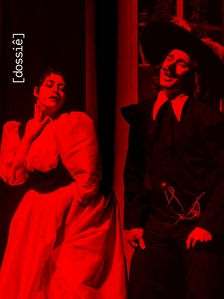The representation of absence
costume scenography of mid-life women
DOI:
https://doi.org/10.26563/dobras.v18i43.1894Palabras clave:
Costume, Ageism, Performed Scenography, Women’s Theatre, MenopauseResumen
The paucity of life narratives in film, television and for stage productions focused on women between the ages of 45 and 60 years has led many of these women to experience a sense of having become invisible. To address this phenomenon, I instigated a cycle of four performances staged between 2017 and 2020. Ideas were developed across the whole cycle and also for each performance. In this article I refer throughout to one performed costume scenography in June 2019, in a South London park. As the scenographer who wrote, directed and designed the perfor- mance, I will be discussing the whole process of creation, the subversive elements and how the blurring of boundaries fostered the audience engagement. This discussion includes the context, the development and experimentation with ideas; the interviews that I made with mid-life women using a Photo-Elicitation method, and the realised performance itself. Audience responses captured on the day, formed the data analysis for the final reflection on the achievements of the work.
Descargas
Citas
AUGÉ, Marc. Non-places: introduction to an anthropology of supermodernity. London & New York: Verso, 1995.
BAUGH, Christopher. Theatre, Performance and Technology: The Development of Scenography in the Twentieth Century. Basingstoke: Palgrave Macmillan, 2005.
BEARD, Mary. The Parthenon. London: Profile Books, 2010 [2002].
BURNS, Elizabeth. Theatricality: A Study of Convention in the Theatre and in Social Life. London: Longman,1972.
CASE, Sue-Ellen. Feminism and Theatre. New York: Methuen, 1988. DOI: https://doi.org/10.1007/978-1-349-19114-7
HARRIS, Geraldine. Staging Femininities. Manchester: Manchester University Press, 1999.
HARVIE, Jen. & LAVENDER, Andy. (eds) Making Contemporary Theatre. Manchester: Manchester University Press, 2010.
HARPER, Douglas. Talking about pictures: A case for photo elicitation. Visual Studies, 17, 13-26. doi:10.1080/14725860220137345, 2002. DOI: https://doi.org/10.1080/14725860220137345
HNATH, Lucas. A Doll’s House, Part 2. New York: Theatre Communications Group Inc, 2018.
HOMER. Translators Emile V. Rieu revised by Dominic C.H. Rieu The Odyssey. London: Penguin, 2003 [1946].
HOWARD, Pamela. with DRÁBEK, Pavel. What Is Scenography? 3rd ed. New York: Routledge, 2019. DOI: https://doi.org/10.4324/9781315146232-3
IBSEN, Henrik. Translator James McFarlane Four Major Plays: Doll’s House. Oxford: Oxford University Press, 1981 [1879].
inVISIBLEwomen. Women On Top of Plinths. Available at: https://invisiblewomen.org.uk. Last visited: 20 jan. 2025.
KINCHELOE, Joe. L. Describing the bricolage: Conceptualizing a new rigor in qualitative research. Qualitative Inquiry, 7, 679-692. doi:10.1177/107780040100700601, 2001. DOI: https://doi.org/10.1177/107780040100700601
LE GUIN, Ursula. K. Dancing at the Edge of the World: The Space Crone. New York: Grove Press, 1989.
LEHMANN, Hans-Thies. Translator Karen Jürs-Munby. Postdramatic Theatre. London: Routledge, 2006. DOI: https://doi.org/10.4324/9780203088104
LÉVI-STRAUSS, Claude. The Savage Mind. London: Weidenfeld & Nicolson, 1966 [1962].
LOTKER, Sodja. & GOUGH, Richard. 2013. On Scenography: Editorial. Performance Research, 18, 3-6. doi:10.1080/13528165.2013.818306, 2013. DOI: https://doi.org/10.1080/13528165.2013.818306
MCKINNEY, Joslin. & BUTTERWORTH, Philip. The Cambridge Introduction to Scenography. Cambridge: Cambridge University Press, 2010. DOI: https://doi.org/10.1017/CBO9780511816963
NELSON, Robin. Practice as Research in the Arts: Principles, Protocols, Pedagogies, Resistances. Basingstoke: Palgrave Macmillan, 2013. DOI: https://doi.org/10.1057/9781137282910
PALMER, Amanda. The Art of Asking: How I Learned to Stop Worrying and Let People Help. London: Piatkus, 2014.
PHELAN, Peggy. Unmarked: The Politics of Performance. [e-library]. London: Taylor & Francis, 2005 [1993].
SCHECHNER, Richard. A new paradigm for theatre in the academy. TDR: The Drama Review, 36, 7-10, 1992. DOI: https://doi.org/10.2307/1146210
SCHÖN, Donald. A. The Reflective Practitioner. Guildford: Ashgate, 2011 [1983].
SEGAL, Lynne. Out of Time: The Pleasures and the Perils of Ageing. London: Verso, 2013.
THE INCLUSION LISTS. Inclusion Initiative. USC Annenberg. Available at: https://www.inclusionlist.org. Last visited: 20 jan. 2025.
TRIGGE, Madaleine. Sutre. Aesthetica, 2009. Available at: https://aestheticamagazine.com/profile/madaleine-trigg /. Last visited: 20 jan. 2025.
WARNER, Marina. Monuments and Maidens: The Allegory of the Female Form. Los Angeles: University of California Press, M. 2000 [1985].
WOLLSTONECROFT, Mary. A Vindication of the Rights of Women. London: W. Scott, 1792.

Descargas
Publicado
Cómo citar
Número
Sección
Licencia
Derechos de autor 2025 Hilary Baxter

Esta obra está bajo una licencia internacional Creative Commons Atribución-NoComercial-CompartirIgual 4.0.
Direitos Autorais para artigos publicados nesta revista são do autor, com direitos de primeira publicação para a revista. Em virtude de aparecerem nesta revista de acesso público, os artigos são de uso gratuito, com atribuições próprias, em aplicações educacionais e não-comerciais








